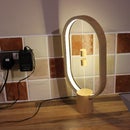Introduction: Hiro Hamada Papercraft Helmet
This instructable details the process I used for creating a paper craft version of Hiro Hamada's Helmet. Hiro is the main character from Big Hero 6 and my son really wanted to dress up as Hiro for a birthday party so I was happy to oblige. I left it until the night before so I'm quite pleased with the result but I advise giving yourself a bit more time if possible.
The helmet was taken from a 3D model of Hiro that I found online. There were multiple sources for the model with varying degrees of downloadability. I eventually found one that opened and managed to convert it to a file format I could work with. I've attached the new 3D model below.
The helmet was converted to papercraft using Pepakura, it was then laser cut for ease (but could easily be hand cut) and then assembled.
Step 1: 3D to 2D Conversion
The initial 3D model was a complete version of Hiro, body and all. I was fortunate to find that the helmet was mostly separated from the rest of the model. I was able to select all of the body parts and delete them from the model leaving only the helmet. The Helmet was built with an inner skin and an outer skin to give it some thickness in the model. I removed all of the inner skin so it was quicker and easier to build.
I used Cinema 4D for all my editing because that is the modelling package I know from many moons ago. I am sure this could be done in some of the free modelling packages that have cropped up since 3D printing came along.
Once I had a 3D model featuring only the parts I wanted to build I exported in the 3DS format and opened it in Pepakura. Pepakura attempts to flatten out the 3D model into 2D parts that can be printed onto paper, these parts can be cut out and assembled. Some work is required to lay out the model as economically as possible for A4 paper and to move the tabs into the correct places.
I've attached the model here as a PDF so anyone can print it and cut it out with scissors or a scalpel, I'm a bit lazy though and I have a laser cutter so I used that to cut it out instead.
Hiro Hamada Credit: Ripped by Mystie from The VG Resource.
Step 2: Laser Cutting Colour Pepakura
To get the data out of Pepakura I use a PDF printer like Bullzip PDF. PDF is a useful data format because it preserves raster data (the actual images) and the vector artwork of the lines we'll be cutting along. Print out one set of parts using a normal colour printer and printed on to thin card, this is the card you'll be placing under the laser for cutting.
I also opened the PDF in Inkscape, this allowed me to remove the raster images and re-save the file as DXF for importing to the laser cutter software. Once it was converted to the new format I opened it in Lasercut 5.3 and selected appropriate settings for cutting cardboard.
The difficult step is aligning the colour print out with the laser cutter, it is really hard to align the laser with an existing part so the trick is to let the laser show you where to put the work piece. There are registration marks in each of the 4 corners of the PDF prints, these can be used to manually calibrate the laser. I measured the distance between these marks and cut out a hole in a sheet of card that was stuck down to the laser bed. I cut each of the printed sheets down to the same size. The prints are now the same size as the hole and the hole shows you exactly where to put each of the prints.
The laser cuts cardboard really quickly (50mm/s in my case) so 20 minutes later all of the parts were cut out and ready to be assembled.
Step 3: Finishing Out the Costume
With all the parts cut, the rest is all about assembly, I used UHU glue to hold the card together. The fins on the ears were still separate parts and didn't have attachment holes on the helmet so I used a scalpel to make holes in the right places. I then hot glued them in place (hot glue provides bulk and fills voids between the fins and the helmet). A quick coat of black on the inside of the helmet and it was ready to go.
For me costume making is all about the details, so I filled it out with knee and elbows pads making them look right with a quick coat of shiny purple paint. I also converted a regular belt into a utility belt, it now has little pouches all over it that were just scraps of corrugated card wrapped in black cloth tape I then stuck them to the belt with more tape. A long sleeve T-Shirt and 3/4 length trousers (or at least trousers he'd grown out of) and it's not bad for an impromptu night-before costume.
The helmet just about survived the party, the weak parts (the chin and fins) are quite worn and loose but could easily be rebuilt. If it needed to survive for longer than I would have made those bits stronger, but it served the purpose and most people didn't even realise it was hand made which is a bonus.
This Instructable was written by Martin Raynsford, Martin is a farther of two and is half of Just Add Sharks Ltd, a British company that supplies laser cutters to evil geniuses... amongst others. You can find more of Martin's builds on his blog or on his Instructables page. You can see more laser cut projects on the Just Add Sharks Blog.








